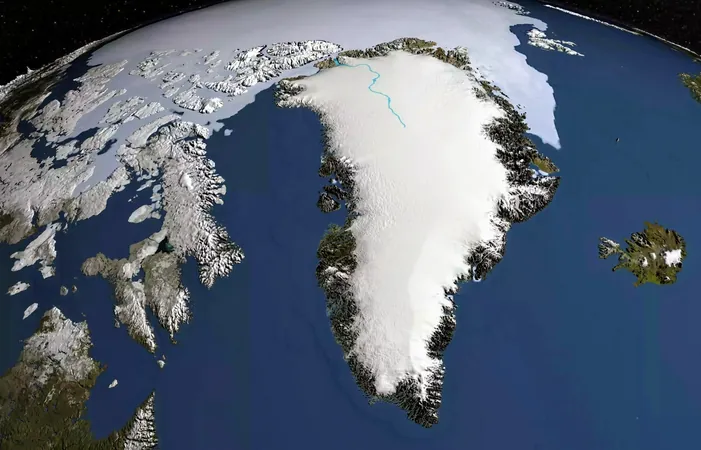
Drones Uncover Crucial Insight into Greenland's Ice Melting Crisis
2025-03-30
Author: Daniel
For the first time, pioneering scientists have successfully utilized a custom-built drone to collect detailed measurements of water vapor from high above Greenland's expansive ice sheet. This innovative approach marks a significant advancement in understanding the dynamics of water movement across and away from the icy territory, providing a critical step towards refining models that predict ice loss in the rapidly changing Arctic climate.
A Melting Giant with Global Consequences
Greenland's ice sheet holds approximately 8% of the world’s freshwater supply, yet it is rapidly diminishing. According to the National Oceanic and Atmospheric Administration (NOAA), from fall 2023 to fall 2024, the island lost an astounding 55 gigatons of ice and snow—an amount sufficient to fill over 20 million Olympic-sized swimming pools.
This significant ice loss has been a consistent trend for nearly three decades, with more than 5 trillion tons of ice melting since 1992. While much of this loss is visible—primarily from glaciers calving into the ocean and surface melting—less visible processes such as sublimation (the direct transformation of ice into vapor) also play a crucial role. In certain areas of Greenland, research suggests up to 30% of summer snow may sublimate into the atmosphere, but the fate of this vapor has remained a mystery until now.
Understanding whether this vapor recondenses and returns to the surface or escapes the system entirely is vital to calculating Greenland's long-term water balance and predicting its contributions to sea level rise.
Drones: Navigating New Heights
Traditionally, the study of Arctic water vapor required expensive air travel into challenging environments, followed by painstaking lab analysis of collected air samples. Rozmiarek’s team innovatively employed drone technology to overcome these barriers. Equipped with advanced sampling technology and a 10-foot wingspan, the drone made 104 flights during the summer of 2022 from a research camp run by the University of Copenhagen's East Greenland Ice-Core Project.
On each mission, the drone ascended nearly 5,000 feet, collecting air samples at various altitudes, with a focus on measuring isotopes—unique combinations of hydrogen and oxygen within water vapor molecules. These isotopic signatures serve as molecular "fingerprints," enabling scientists to trace the origin of the vapor.
Rozmiarek remarked, "Isotopes are water's fingerprints. By following these fingerprints, we can trace back to the source where the water vapor came from," emphasizing the utility of this method in understanding Arctic water dynamics.
Transforming Climate Models
Upon gathering the isotopic data, the research team compared their findings with existing climate models of the Arctic water cycle. The results revealed a significant underestimation in the predicted precipitation levels on Greenland. When the new isotopic data was incorporated into the simulations, the model aligned more closely with observed reality.
"The ability to predict Greenland's future in our warming world is crucial," Rozmiarek noted. "We demonstrated how useful water vapor isotope data is by successfully improving an existing model." This refinement could enhance predictions related to ice melt rates, atmospheric circulation, and the far-reaching impacts of Greenland’s ice changes on global weather patterns.
The Sensitivity of Greenland's Ice to Climate Change
Historical data indicates that Greenland's ice is highly sensitive to warming. During a naturally warmer period around 125,000 years ago, the ice sheet was significantly smaller, and global sea levels were as much as 19 feet higher than they are today. As the planet continues to experience increasing temperatures, worries mount that we may again be on a path toward this alarming scenario.
The United Nations reports that sea level rise already affects one billion people worldwide, threatening numerous communities and ecosystems. Gaining insights into how quickly and in what ways Greenland's ice sheet could respond to further warming is essential for developing effective adaptation strategies.
Looking Ahead to Future Research
Rozmiarek aims to return to Greenland for additional drone flights, extending this innovative methodology to other Arctic regions. While this research is still in its infancy, its implications are immense. "It’s like we’ve just figured out how to discover fingerprints at a crime scene," Rozmiarek stated. "This is a significant step forward in understanding the vital water flows in this region at a critical time."
By combining advanced drone technology with isotope analysis, scientists are gradually piecing together the hidden elements of water movement that will shape the future of one of our planet’s most vulnerable ecosystems.
The study has been published in the journal JGR Atmospheres, marking a transformative step in Arctic research. This research serves as a wakeup call to the urgent need for global awareness and action regarding climate change and its far-reaching impacts.



 Brasil (PT)
Brasil (PT)
 Canada (EN)
Canada (EN)
 Chile (ES)
Chile (ES)
 Česko (CS)
Česko (CS)
 대한민국 (KO)
대한민국 (KO)
 España (ES)
España (ES)
 France (FR)
France (FR)
 Hong Kong (EN)
Hong Kong (EN)
 Italia (IT)
Italia (IT)
 日本 (JA)
日本 (JA)
 Magyarország (HU)
Magyarország (HU)
 Norge (NO)
Norge (NO)
 Polska (PL)
Polska (PL)
 Schweiz (DE)
Schweiz (DE)
 Singapore (EN)
Singapore (EN)
 Sverige (SV)
Sverige (SV)
 Suomi (FI)
Suomi (FI)
 Türkiye (TR)
Türkiye (TR)
 الإمارات العربية المتحدة (AR)
الإمارات العربية المتحدة (AR)